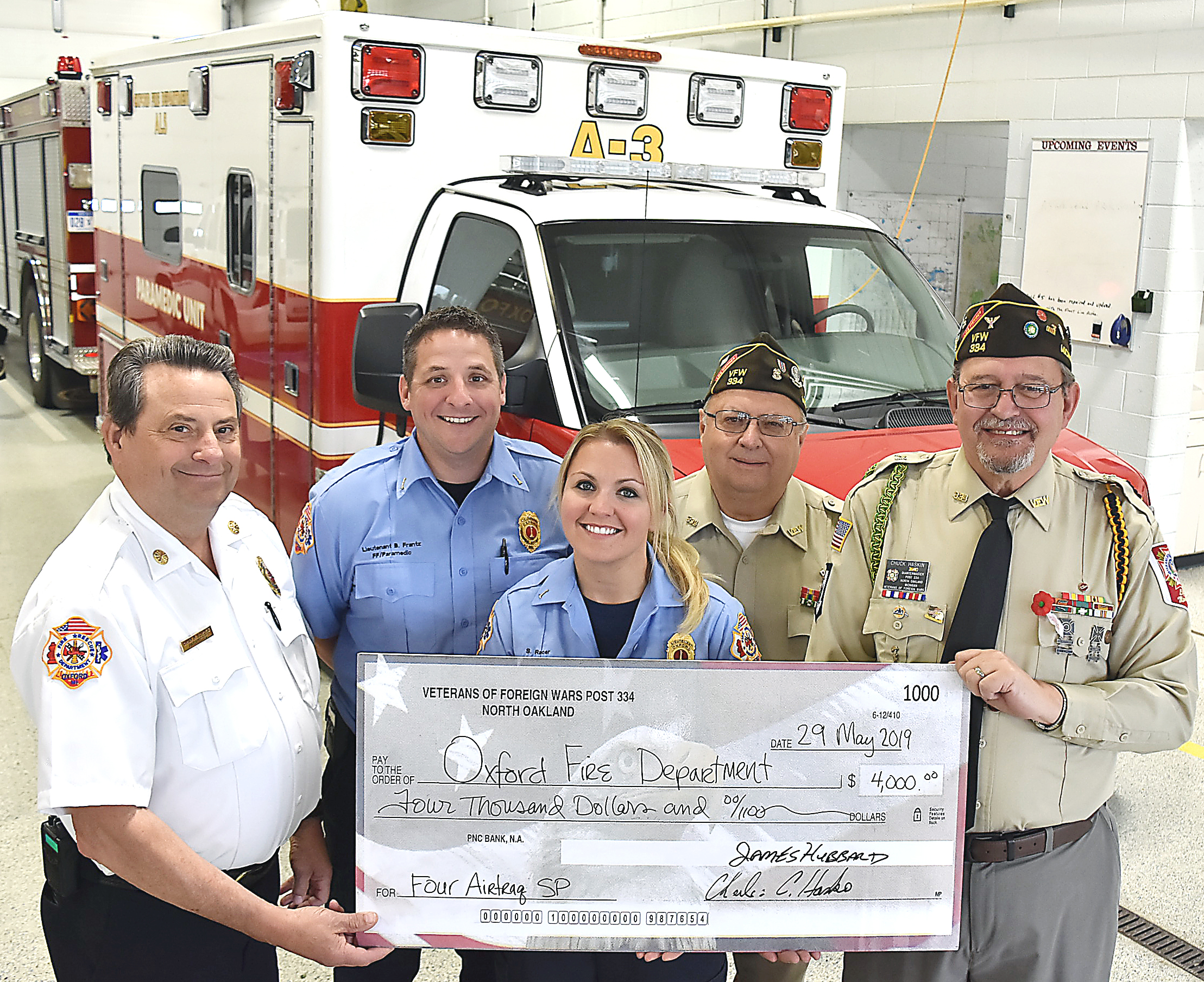
Thanks to a local veterans group, the Oxford Fire Department has some life-saving equipment that will help patients in need of emergency medical services literally breathe easier.
North Oakland Veterans of Foreign Wars (VFW) Post 334 donated $4,000 for the purchase of four video laryngoscopes, one for each of the department’s ambulances.
Laryngoscopes are used by paramedics in situations where patients cannot breathe on their own. The laryngoscope helps first-responders guide a breathing tube, or endotracheal tube, in a patient’s throat. The goal is to get the tube into the trachea, the large airway between the mouth and lungs.
Lt. Sarah Racer, the fire department’s EMS coordinator, said the new laryngoscopes should make it simpler and quicker to intubate patients because the small camera and video display attached to each of them provides users with a clear and complete view of the throat’s interior as they’re guiding the tube in.
“They say that it’s got a 95 percent success rate (when it comes to) intubating a patient,” she said.
In addition to the camera and video display, the video laryngoscope has a “big, bright LED light on it” that illuminates the entire airway. “You can actually see what you’re doing,” Racer said.
According to Racer, right now, the department typically doesn’t intubate patients because of how difficult the procedure can be with traditional laryngoscopes, which lack video technology.
All of Oxford’s paramedics are trained on how to use traditional laryngoscopes, but Racer said they “don’t get enough practice” with them in the field to become “proficient” at intubation.
“It’s not something we do on a daily basis,” she explained. “(Intubation is) one of those skills that needs a lot of practice. We can practice on mannequins, but it’s not like the real thing.”
As a result, Racer said “nobody wanted to intubate anymore,” so supraglottic airway devices became the go-to option to help patients breathe.
“We probably use that 95 percent of the time,” she said. “It works, but it’s not ideal.”
She noted supraglottic airway devices were originally supposed to be used as a last resort if a patient could not be intubated. “Now, it’s become our first line of defense,” she said.
According to Racer, 90 percent of the time supraglottic airway devices end up in a patient’s esophagus, which is where they’re designed to go. If it ends up in the trachea, “it’s a very lucky shot,” she noted.
Racer is not a fan of these devices because she said they are not as effective at supplying air to the lungs and they don’t protect the airway as well as endotracheal tubes. They can also become “dislodged.”
In contrast, endotracheal tubes send air directly into the lungs and ensure “nothing else” gets into them. Racer called them “the Cadillac of airways.”
She explained that if things such as vomit and blood get into patients’ lungs that can make it “harder” for them to “survive” because an infection can develop.
“Making sure that a patient has a secure airway has been proven to help save lives and (give patients) better outcomes in the long run. They have a better chance of survival,” Racer said.
Racer believes the video laryngoscopes will motivate Oxford paramedics to intubate every patient who needs it.
“Everybody’s going to be trained on it,” she said. “I think they’ll see how easy it is and people will be excited to use them. They’re a great tool.”
Racer also likes that unlike traditional laryngoscopes, use of the video versions doesn’t require medics to briefly stop administering CPR during intubation.
“There are no interruptions,” she said.
Chuck Haskin, quartermaster for VFW Post 334, said the group was happy to help the fire department and the community by purchasing these devices.
Haskin said what happens during the “first few minutes” of a medical emergency can “really mean the difference between life and death,” so if these video laryngoscopes “can save one life, it will be well worth the $4,000.”
He noted the donation came from Post 334’s Relief Fund, which is supported by the VFW’s annual Buddy Poppy fund-raiser.
Racer, whose father, Mike, is a Vietnam War veteran and a member of Post 334, appreciates the donation and “how heroic” these veterans are for their continued efforts to improve people’s lives and keep them safe.
“Every single day these guys are doing something to help others and their communities,” she said.

Leave a Reply